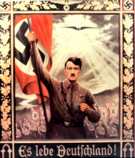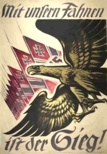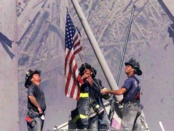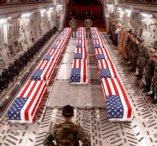flag - A piece of cloth or other material,
usually rectangular, of distinctive
color and design, used
as a standard, sign,
or emblem. Flags are typically
flown from a vertical or
diagonal staff; the rope
which hoists it called a halyard. The edge
of a flag adjacent to the staff is called its hoist edge, while
the opposite one is its fly edge. The shapes
and figures and their
arrangement in the design
of a flag are generally described in the same terms used to describe
heraldic designs.
A triangular flag is known as a pennant. A really long one is called a streamer.
A military flag might be called an ensign, a standard, or an ancient. A ship's flag is often called an ensign or a jack. A pirate's flag is a "Jolly Roger." Flags, especially those on a boat, or the light cloth used in making them is called bunting.
A flag that hangs from a horizontal bar may be called a banner or a gonfalon.
The study of flags is called vexillology.
Flags are often designed or redesigned when a country's name or borders are changed, or when its type of government radically changes.
Artists have designed flags. They have also made flags the subjects of other works. There are several examples both of actual flags and of paintings depicting flags below.
Like a nation's name, its flag is among its most potent symbols — patriotic and political. As one publicly honors or abuses a nation's flag, one symbolically honors or abuses that nation — its government, its people, its interests.
In 1989 the U.S. Supreme Court ruled that burning the American flag in public to protest government policies is a right protected by the First Amendment of the U.S. Constitution. One contemporary artist placed the American flag on a floor, and another placed it in a toilet. Each has been guaranteed protection under the Constitution's guarantee of freedom of speech.
Flags of Nations of the World:
Other flags
Examples of art in which flags appear:

John Singleton Copley (American and British, 1738-1815), The Death of Major Peirson, 6 January 1781, 1783, oil on canvas, 251.5 x 365.8 cm, Tate Gallery, London.

Emanuel Gottlieb Leutze (German-American, 1816-1869), Washington Crossing the Delaware, 1851, oil on canvas, 149 x 255 inches (378.5 x 647.7 cm), Metropolitan Museum of Art, NY. This painting depicts General George Washington's attack on the Hessians at Trenton on December 25, 1776, during America's revolution against England. A print published in 1853 gave the painting the status of a national monument, in spite of numerous errors in historical detail (the flag, for example, as depicted here was not introduced until six months after the event). Nevertheless, the painting captured and has held the affection of succeeding generations of Americans, for the drama of the episode, despite the histrionics, has great patriotic appeal.

Henry Peters
Gray
(American, 1819-1877), The Birth of Our Flag (aka Origin of the American Flag), 1874, oil on canvas, 72 x 48 inches, National Academy of Design, NY.

Claude Monet (French, 1840-1926), Garden at Sainte-Adresse, 1867, oil
on canvas, 38 5/8 x 51
1/8 inches (98.1 x 129.9 cm), Metropolitan Museum of Art, NY.
See Impressionism.

American, Jefferson County, New Jersey, Ripple Flag Fence Gate, 1877-1890, painted wood construction. See folk art.

Childe Hassam (American, 1859-1935), The
Fourth of July, 1916 (The Greatest Display of the American Flag
Ever Seen in New York, Climax of the Preparedness Parade in May),
1916, oil on canvas,
36 x 26 1/8 inches (91.4 x 66.4 cm), Private collection. America
entered World War I in April of 1917, but patriotic fervor was
already running high in 1916. That year, Childe Hassam began
to paint a series of flag paintings, based on the nationalistic
displays of flags, banners, and bunting on the buildings that
lined Manhattan streets. See American
Impressionism and Ten American Painters.

Childe Hassam, Allies Day, May 1917, 1917, oil
on canvas, 36 1/2 x 30
1/4 inches (92.7 x 76.8 cm), National Gallery of Art, Washington,
D.C. Here the flags of four nations allied in the war mingled
above Fifth avenue and 52nd Street.

F. Childe Hassam, Avenue of the Allies: Brazil, Belgium, 1918, oil on canvas, 36 1/4 x 24 1/4 inches (92.1 x 61.6 cm), Los Angeles County Museum of Art.

Childe Hassam, Avenue of the Allies, Great Britain, 1918,
1918, oil on canvas,
36 x 28 3/8 inches (91.4 x 72.1 cm), Metropolitan Museum of Art,
NY. The flags of twenty-two allied nations along Fifth Avenue.

Childe Hassam, Flags on Fifty-seventh Street, The Winter of
1918, 1918, oil
on canvas, 35 3/4 x 23
3/4 inches (90.8 x 60.3 cm), New-York Historical Society, NY.

Childe Hassam, Red Cross Drive, May 1918 (Celebration Day),
1918, oil on canvas,
35 1/2 x 23 1/2 inches (90.2 x 59.7 cm), collection of the May
family.

Childe Hassam, Victory Day, May 1919, 1919, oil
on canvas, 36 x 21 3/4
inches (91.4 x 55.2 cm), American Academy of Arts and Letters,
NY. There were at least twenty-three paintings in Hassam's seris
of flag paintings.
Paul Strand (American, 1890-1976), Fifth Avenue, New York, 1915, platinum print, 12 1/4 x 8 1/4 inches (31.2 x 20.8 cm), Museum of Modern Art, NY. See photography.

German, Long live Germany! (Es lebe Deutschland!) , after 1936, poster, collection of Dr. Robert D. Brooks. This poster casts Hitler as a sainted hero. A Holy Spirit-like / dove-like eagle flies in the radiant glow above an idealized Hitler, reminiscent of Baroque paintings of Christ in scenes with John the Baptist. See fascist aesthetic and propaganda.

German, Our Flags are Victory! (Mit unfern Fahnen ist der Sieg!), 1940, poster. 650,000 copies were distributed by the Nazis during World War II.

Joe Rosenthal (American, 1911-), Soldiers Hoist the Stars and Stripes at Iwo Jima, February 23, 1945, photograph. This iconic photograph actually shows the second flag-raising to celebrate the recapture of the island from the Japanese. Although Rosenthal did not stage this scene at all, as was rumored, he has had to answer the rumor ever since 1945. Mitchell Landsberg's story for AP about the photo includes, "The battle for Iwo Jima was the costliest battle in Marine Corps history. Its toll of 6,821 Americans dead, 5,931 of them Marines, accounted for nearly one-third of all Marine Corps losses in all of World War II. Rosenthal's picture has been called the greatest photograph of all time. It may well be the most widely reproduced. It served as the symbol for the Seventh War Loan Drive, for which it was plastered on 3.5 million posters. It was used on a postage stamp and on the cover of countless magazines and newspapers. It served as the model for the Marine Corps War Memorial in Arlington, Va., a symbol forever of the valor and sacrifices of the U.S. Marines." See memorial.
Jasper Johns (American, 1930-), White Flag, 1955, encaustic, oil, newsprint and charcoal on canvas, 78 3/8 x 120 3/4 inches (198.9 x 306.7 cm), Metropolitan Museum of Art, NY. See Pop Art.

Faith Ringgold (American, 1930-), The Flag is Bleeding #2, from the series "The American Collection," #6, 1997, acrylic on canvas; painted and pieced border, 76 x 79.5 inches. See African American art, Afrocentrism, and feminism and feminist art.

René Mederos (born Felix René Mederos Pazos) (Cuban, 1933-1996), designer, OSPAAAL, publisher, Vietnam, 1967, offset lithographic poster, 54.5 x 34 cm. The US flag is analogous to another emblem of the American nation — Uncle Sam, and further to Uncle Sam's top hat — in this ruined condition representing the defeat of the US in the Vietnam War.

Wayne Eagleboy (American, Onandaga tribe, contemporary), We the People, 1971, acrylic paint and barbed wire on buffalo hide, Art Wagon Gallery. Contemporary Native American Wayne Eagleboy's version of the US flag bears portraits of two Indian men behind a screen of barbed wire. The painting is framed by the fur attached to its reverse.

Yolanda López (American, 1942-), Portrait of the Artist as the Virgin of Guadalupe, 1978, oil pastel on paper, 32 x 24 inches, collection of the artist. See feminism and feminist art and mandorla.

Thomas E. Franklin (American, contemporary), Firefighters Raise a Flag at Ground Zero, 2001, photograph, The Record, Bergen County, NJ.

U.S. Defense Department, U.S. Flag Draped Coffins Returning from Iraq,
2004, photograph. The US government has tried to limit the public's access
to photographs of large numbers of such coffins. This and 360 other photographs of related subjects
taken at Dover Air Force Base in Delaware can be seen at the
Memory
Hole.
Also see heraldry, icon, logo, seal, symbol, and textile.
https://inform.quest/_art
Copyright © 1996-![]()